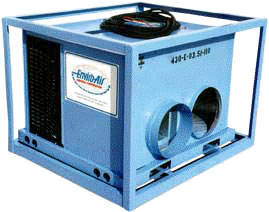Why use Dehumidification?

During Abrasive Blasting
It is generally accepted that for corrosion to occur all four of the following components must be present:
1. Anode - A metal, in contact with the electrolyte, which corrodes (gives up energy)
2. Cathode - A metal, in contact with the electrolyte, which does not corrode (gives up energy)
3. Conductor - A metal which connects the anode and the cathode to complete the circuit for current flow
4. Electrolyte - Conducts current
During Coating Application
Due to the U.S. Clean Air Act Amendment of 1990 and air quality regulations enacted by other governmental agencies, the majority of the coating/lining manufacturers are reducing the volatile organic compounds (VOC's) in their products. However, as long as there are solvents in the formulation, the following scenario can occur during the application of the lining material.
The lining material is atomized as it passes through the spray gun nozzle. This is the beginning of the solvent evaporation process. However, once the material has reached the surface and has become a "wetted" film, the solvent continues to evaporate. At this point in time two potential problems can occur:
1. The air flow through the enclosure may have to be adjusted since it now must be capable of exhausting this evaporating solvent. This is discussed in more detail in the "During Curing of the Coating" Section.
2. Solvent evaporation is a cooling process. Therefore, as the solvent evaporates from the "wetted" film, the coated surface has a tendency to cool and its temperature will actually be less than either the air within the enclosure or the surface to which it has been applied. Because of this phenomenon, most specifica tions include the phrase "...the surface temperature must be at least 3° C (5° F) above the dew point..."
However, if this surface temperature can not be met due to external ambient conditions, one can either:
1. Raise the temperature of the steel surface. It is not practical, logical, or cost effective to raise the surface temperature of the entire steel tank - especially if it is not insulated, which is generally the case.
2. Reduce the dew point of the air within the enclosure. This is the obvious choice. This can be done only by dehumidification procedures. Heating of the air does not reduce the dew point - it merely reduces the relative humidity.
During the Curing of the Coating
As previously stated, water vapor is present at all times in the air. Also, at a given temperature and atmospheric pressure this air can hold only a fixed amount of liquid in the vapor state. Or, to put it another way, each cubic foot of air can hold only a fixed amount of evaporated liquids.
After a lining has been applied, the solvent release ideally continues until the lining has cured. If it can not be totally released and exhausted from the film, solvent will be retained in the film and premature lining failure will occur. There are two directions a contractor can go to resolve the above problem. Since a given cubic foot of air with a given relative humidity (a function of the amount of water in the vapor state that is found in the air) and temperature can retain only a fixed amount of solvent, the air flow can be increased so that more air passes through the enclosure and thus all the solvent can be removed. However, this could become prohibitive due to the required size and cost of the equipment plus the additional cost of power to run the equipment - especially if the exterior ambient air is almost saturated due to either (a) rain or high humidity or (b) low temperatures.
The second, and the most practical and cost effective solution, would be to utilize dehumidification equipment. Under the scenario above, the amount of water vapor in the air within the enclosure would be substantially reduced which in turn allows each cubic foot of air to retain additional solvent. This is true regardless of the exterior ambient air conditions. Typically a specification will call for 85% Relative Humidity, or less, during this operation. If this Relative humidity figure were to be reduced, the curing rate could be accelerated and the tank could be returned to service even more quickly.
Enviro-Air Control Corp., 1523 N. Post Oak Rd., Houston, TX 77055-8409. Tel: 713-681-3449; Fax: 713-688-8273.
